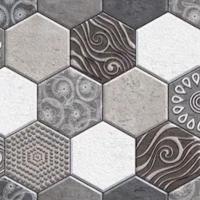Installing Kitchen Wall Tile
by Guest Post on May 7, 2012
Installing wall tiles in the kitchen between the backsplash and the wall cabinets is an easy task to accomplish. Tile stands up to the necessary cleaning behind a range or cutting board better than paint and is very economical. To start with, we have to make a few design decisions. The first one is to select the tile that appeals to you. This is the part of the project that I can't help you with. Unless I receive orders to the contrary, I normally stick with white or off-white.
The color you choose for the grout should complement the tile color. I normally go with (big surprise) off-white. Others like a dark grout to make the grout lines stand out. The third design decision is the space that you will allow between the tile. I prefer tight grout lines in the kitchen (1/16") but wider lines (1/8" - 3/16") in the bath. The width of the grout line will determine whether you need to be sanded or non-sanded grout. Non-sanded grout should only be used when the grout will fill a gap 3/16" or smaller. Sanded grout may also be used on 3/16" grout lines but nothing smaller.
Preparation
The wall where you are placing your tile should be clean and free of debris. It also needs to be fairly straight. Beyond leveling the surface, the amount of surface preparation necessary will depend on the tile adhesive you use and the amount of abuse that the tiles will receive. The example in the photos for this project is simply drywalled with a coat of latex primer. The tile adhesive we used was purchased from a local hardware store, nothing special. Check the mastic's label to make sure that it is compatible with your surface.
Layout
Another task you must accomplish is to locate the center of the wall you want to tile. Measure from end to end and make a mark in the center. Use a square to extend this line from the countertop up to where the tile will stop. Now, center a tile on this line and layout an entire course. This will help you make adjustments so that the cuts on the tiles at the end of the course are the same. When placing the tile on the wall, I normally work from the center out. If the area you are tiling is large you might want to use a chalk line to snap a straight line.
Adhesive
For most backsplashes, a wall-grade mastic is generally sufficient. Mastic is nice to work with as it has a longer open time than thin-set. Normal wall tile will hold nicely with mastic but some stone tiles need special adhesives. Marble is a good example.
Put the adhesive on the wall
The adhesive goes onto the wall with the notched trowel. I used a trowel w/ 1/4" notches for the job so that the "Corn Rows" would show up. You should probably use one with smaller grooves for a 4"x4" tile. When applying the adhesive, use the flat edge to apply a layer of adhesive first. Next, hold the trowel at a 45-degree angle to the wall and "comb" the mastic out. The result should be nice even "corn rows" of adhesive. Don't get too far ahead of yourself, only put up as much adhesive on as you can cover in the next several minutes, especially if you have to cut the tile as you go.
Placing the Tile
Work from the center of the wall towards the edges. When you push the tile against the adhesive you should use a slight twisting motion to set the tile firmly in the adhesive. If you are using spacers, now is the time to set the spacers on the outside edge of the tile to work on the next row of tiles. In the installation pictured, I had to work around several outlet boxes. When you are planning how to cut the tile to go around an obstruction, keep in mind that you should use a "cookie-cutter" approach. Plan your cuts so that the tile flows around the obstruction. Do not get caught piecing together tile around an outlet to fill a row! There are several ways to cut tile. Try a Jig Saw. After all of the tiles have been placed and the adhesive has set up a bit, clean the adhesive from between the tiles and from their faces. A toothpick is a great tool for this. Allow the adhesive to set up overnight before grouting the tile.
Grouting Tile
After the tile adhesive has had time to dry (usually overnight) it is time to grout the tile. Remember to choose sanded or non-sanded grout depending on the spacing you used. Most wall tile installations use non-sanded grout. Grout is also available pre-mixed or dry. The dry mix is easy to blend, just follow the instructions. It should be fairly thick, but not so thick that you can't force it into the joints (gaps). After the grout is ready to go, take your foam rubber float or other appropriate implement and scoop some grout out. Place the grout on the wall and hold the rubber float at a 45-degree angle to the workpiece run the float parallel to the joints in the tile. Round up the excess grout and run the float over the surface several times to fill in the joints. When the gaps are full, run the float over the surface at a 45-degree angle to the joints. Run the float over the surface several times until most of the grout is either in the joints or on the trowel.
Cleaning Excess Grout
Allow the tile to set up for 15-20 minutes, or until firm, in the joints. Using a damp sponge or cloth wipe any excess from the face of the tiles. Rinse out the sponge or rag often enough to keep it clean. Allow the grout to dry another 45 minutes or until a haze forms on the tiles and use the sponge to polish the surface of the tiles. Be careful not to rub the grout from the joints. If it seems like you just can't get the tile clean then let it dry a bit more. After several hours you should use a clean towel to polish the tiles.
Curing the Grout
For the next three days, before using a grout sealer, lightly mist the grout. On the fourth day, use a grout sealer to ensure a good solid installation. These sealers will keep the grout sealed from stains and water.
Buy Your Tile Online Save Time and Money:
Using the web, you can search, using keywords to help narrow your shopping to the specific items that interest you. If you type in the search term "oak", you will be instantly presented with every single product that has an oak influence of some kind. The systems logically break the results into different flooring categories so that you can see all of the hardwood that is made of oak. You can compare different oak colors and styles without having to leave your chair.
Popular Articles
Three Places to Spend Money on the Exterior of Your Home
When you have the exterior of your home remodeled, you are investing, time, energy and convenience into the project and you want to make sure that...
104955 Views
Homemade Headboards-Make an Upholstered or Wooden Headboard
Homemade headboards can add a lot of personality to any bedroom. They can be coordinated with existing furniture and room decor or they can be the...
80154 Views
When to Use a Brush, Roller or Sponge Brush
Brushes are a good choice for painting trim and woodwork. They are also useful for cutting in the edges around the top and bottom edges and corners...
72828 Views
Creating a Cottage Kitchen with Bead Board
Kitchen decor can range from modern and bold to elegant and elaborate by using strategic kitchen pieces. One of the most popular decorating trends...
58583 Views
Gas Fireplace Diagnostics and Troubleshooting
Follow these steps for diagnosing and troubleshooting Gas Fireplaces repairs. For the average DIYer, this may seem intimidating, depending on the...
35625 Views
Latest Articles
How to Keep Your Home Warm in the Winter
How to Keep Your Home Warm in the WinterAs winter approaches, keeping your home warm becomes a priority for comfort and health. Efficient heating...
on Oct 29, 2025
Why Reliable Furnace Repair is Essential for Winter Comfort
As the cold season approaches, homeowners recognize the critical role that a well-functioning furnace plays in ensuring a warm and cozy living...
on Oct 29, 2025
How Much Does it Cost to Take a Bath?
Plumbers know that a bath may seem like a relaxing luxury, but the real cost extends far beyond your water bill. The average soak uses 35 to 50...
on Apr 8, 2025
10 Concrete Patio Ideas on a Budget
A concrete patio can be a game-changer for your outdoor space. It is durable, versatile, and can be customized to fit your style. But what if you...
on Mar 25, 2025
Tips for Creating a Stunning Personalized Photo on Canvas
Order the unique beauty of a personalized photo on canvas and bring your memories to life. With a customized photo on canvas, you can transform...
on Mar 7, 2025
Featured Articles
What Type of Licensed Contractor Should You Hire?
on Feb 28, 2017
Hire Contractors / Estimates

Looking for a specialty project? There are many types of contractors available for your home improvement needs. Finding the right type of...
Actions
Top Categories
- Garden / Landscaping / Patio — 264
- Kitchen / Bathrooms — 240
- Real Estate / Finance — 203
- Appliance / Repair — 186
- Interior Design / Decor — 184
- HVAC / Air Conditioning — 150
- Cleaning / Maintenance — 144
- Improvements / Remodeling — 131
- Plumbing / Basements — 118
- Floors / Tile / Hardwood — 116
- Doors / Garages — 113
- Safety / Security — 113
Articles Archive
More DIY Articles
Understanding When to Plant Baby Trees
Fall or wintertime is a great time to think about planting baby trees. Most trees survive better if they are planted or transplanted while they are...
5 Ways to Improve Your Home's Energy Efficiency
Are you wondering how to make your home energy efficient? Becoming more efficient can have a vast impact on your electricity bill and make it much...
How to Choose an Audio Interface
An audio interface is a good buy. It enhances the work your computer can do for you by giving you additional components and capabilities. This is...
Fridge on the Brink? It could just be the Seal
The seal on your refrigerator and freezer is what holds the doors closed properly. This ensures that the cold air remains inside and keeps...
5 Tips for Keeping a Clean Home This Winter
Many people think of spring cleaning as the busiest cleaning season of the year. Although most people save all of their de-cluttering for...

